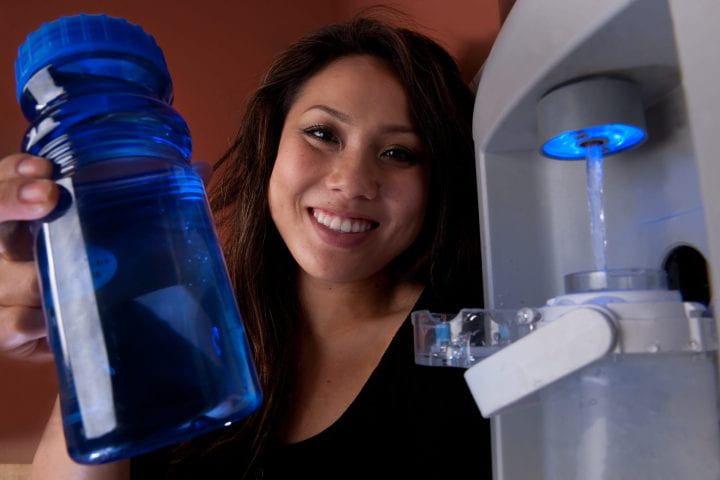Fill 'em up
Students help outfit campus with new hydration stations to turn the tide against wasteful consumption

UC Irvine staffer Amy Provorse was visiting her daughter at Northern Arizona University when she came upon a hydration station where she could refill her beverage container with filtered water – just like the bottled stuff people pay good money for, but it didn’t cost her a cent.
“It tasted like spring water,” she recalls. “I thought it was the hippest thing.”
Provorse, senior superintendent of skilled trades in UCI’s Facilities Management department, liked the hydration station so much she pitched the idea to her colleagues, and in fall 2010 they installed one in Rowland Hall. Students thought the amenity was hip too and began asking for additional stations, but there wasn’t money in the budget.
The project might have run dry if not for An Vinh Tran ’12 and The Green Initiative Fund, a student-run entity that supports sustainability efforts on campus (see related story). Thanks to the unique student-staff partnership, hydration stations have sprung up all over campus, saving water and reducing plastic pollution with every fill-up.
“The typical bottle of water holds a liter. It takes three times that amount plus one-quarter liter of oil to make a plastic bottle,” Tran says. “The stations save oil and water.”
She began her conservation effort two years ago, when she was studying water usage policy and learned of a disturbing statistic: Only 2.5 percent of the world’s water supply is freshwater, and the amount available for drinking, agriculture and other uses is steadily decreasing due to global warming and growing consumption.
“That number bothered me,” she says. “It opened my eyes. We take water for granted because it’s so cheap. But in the future there’s going to be a shortage.”
Tran contacted The Green Initiative Fund and eventually secured two $17,000 grants for six more hydration stations and replacement filters.
“It was a great collaboration between staff and students,” says Anne Krieghoff, Facilities Management’s superintendent of solid waste & recycling services. “We’ve learned how well we work together.”
In spring 2011, Facilities Management, led by plumbing supervisor Juan Tapia, installed the six stations and retrofitted existing water fountains with goosenecks that also delivered filtered water at an additional 22 locations in UCI’s core buildings. To further saturate the campus, The Green Initiative Fund awarded grants for hydration stations to be placed in residence halls, the Student Center and the Cross-Cultural Center.
The stations and goosenecks dispense 60,000 gallons of filtered water per year (based on meter readings), a savings of 475,000 bottles – or 13 tons of plastic. “And that’s a conservative estimate of their environmental impact,” Krieghoff says. “It really adds up.”
Already, the campus has seen a 17 percent drop in bottled-water sales for 2011-12.
To spread awareness of the importance of water conservation and encourage students to use the stations, Tran and Daniel Crout, Facilities Management’s assistant sign supervisor, also created a poster about the freshwater shortage and the environmental toll of plastic bottles. They devised a campus map of station locations that students can download from the posters into their smartphones via a scan tag – another of Tran’s ideas. The posters now hang at all the stations.
“It’s my message to be water-wise wherever they can,” says Tran, who earned bachelor’s degrees in psychology & social behavior and urban studies last June and hopes to pursue a career in water conservation. “I wanted the locations to be more visible.”
So far, the campaign at UCI is having a ripple effect. Facilities Management has received calls from other universities, high schools and water districts interested in the stations, while Tran has happily fielded inquiries from students on other campuses.
I’ve changed a lot of my behaviors, but I can’t do it on my own,” she says.
Students give green light to sustainability projects
For UCI undergraduates, the letters “TGIF” have special meaning. They signify their efforts to save the planet.
Established in 2009 by a student referendum, TGIF – The Green Initiative Fund – awards about $120,000 a year for projects that fight global climate change and shrink UCI’s carbon footprint.
“TGIF is an amazing way for all students to contribute to the campus’s sustainability efforts,” says Katie Chansler, TGIF sustainability commissioner. “UCI is becoming increasingly known for the changes we’re making. We recently ranked ninth nationally on the Sierra Club’s “Coolest Schools” list of greenest campuses.”
Students pay $3.50 per quarter to fund the initiative. They can apply for grants of up to $50,000, and their proposals are reviewed by a committee of five undergraduates.
TGIF has funded a documentary about the harmful effects of plastic water bottles; a solar-powered stage at the annual Wayzgoose festival; recycling bins; energy-efficient computer hardware at the New University student newspaper; and dozens of other green efforts.
“We’ve supported projects that impact the entire student body and encourage everyone to change [his or her] way of life,” Chansler says.
In 2011-12, when she was a resident adviser at the Vista hall in Mesa Court, she witnessed TGIF’s positive effect firsthand.
“TGIF paid for hydration stations in Mesa Court, and they definitely made a difference in how residents got their water. I always saw people filling up their water bottles and rarely saw plastic bottles in our recycling or trash bins,” Chansler says. “TGIF is a great opportunity to support these kinds of inspiring and progressive projects.”